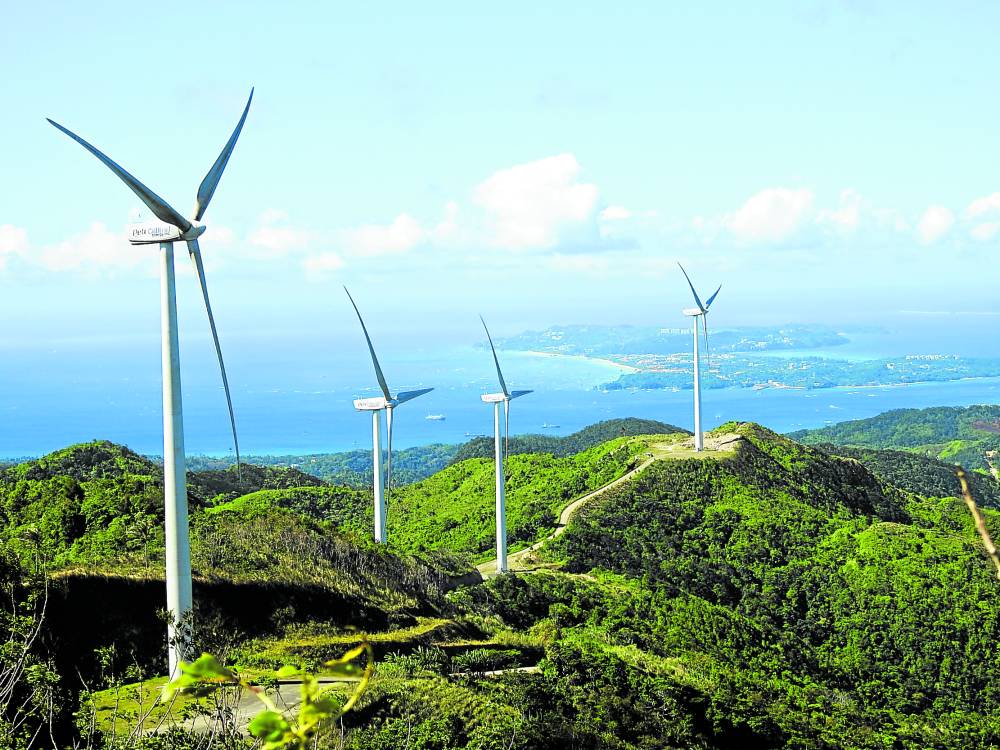
FARM TO GRID The 36-megawatt (MW) Nabas wind power project of PetroWind Energy Inc. is the largest renewable energy facility on Panay Island. —CONTRIBUTED PHOTO
Over the hilly terrains in Aklan province, a wind farm sprawls for kilometers, its turbines harnessing the power of the wind to energize households in the community.
The 36-megawatt (MW) Nabas wind power project operated by Yuchengco-led PetroWind Energy Inc. is among the country’s seven operational facilities that utilize wind energy for power generation. It is the largest renewable energy facility on Panay Island, home to four provinces.
The Nabas wind project, composed of 18 turbines, is expected to contribute to grid stability in the Visayas, while helping avoid 56,773 metric tons of carbon dioxide emissions annually.
The Panay sub-grid, in particular, is heavily reliant on four major coal-fired power plants to meet its 300- to 500-MW demand.
READ: PetroEnergy taps Vestas for wind power project in Aklan
The Philippines is currently in the northeast monsoon (amihan) season, which is characterized by cool and dry winds coming from the northeast. This season typically lasts from October until March. Thus, wind farms in the southwestern part of the country, including Aklan, usually have lower yield.
Despite its volatility, wind is still viewed by key industry players as among the most vital sources of clean energy that can help countries shift to renewables from fossil fuels.
PH wind energy potential
In the Philippines alone, the Department of Energy has so far awarded at least 200 wind energy service contracts with an aggregate potential capacity of 80,263.53 MW. The seven installed facilities have a total capacity of 442.9 MW.
In 2022, the World Bank group also issued a road map showing that the Philippines has the potential to develop 21 gigawatts of offshore wind by 2040 in line with its goal to increase the share of renewables in the energy mix.
READ: Philippines has potential for 21GW wind power by 2040 — World Bank
However, PetroWind points out that despite the Philippines’ vast potential for wind power generation, there remains an uncertainty in its environmental impact.
According to the US Energy Information Agency, wind turbines could have some negative effects on the environment, as most of the materials used to make these cannot be reused or recycled.
It also warned that fossil fuels “may be used” in producing the metals and other materials used to make wind turbine components.
‘Temporary’
Despite these findings, PetroWind says the environmental impact is “typically temporary.”
“Once operational, wind farms often enhance the landscape by blending into the surroundings, coexisting harmoniously with local ecosystems and, in many instances, enhancing ecotourism value of the locality,” the company adds.
The Nabas project itself has been under much scrutiny by environment advocates in the community where it stands, with groups claiming that the second phase would have a negative impact on the Northwest Panay Peninsula Natural Park and the Nabaoy River.
The park, which covers 120.02 square kilometers, is the last remaining low-lying forest on the island that houses various flora and fauna, according to nongovernment organization PhilinCon. It was declared a natural park under Presidential Proclamation No. 186, series of 2002.
Nabaoy River, meanwhile, is the municipality of Malay’s main source of potable water.
In its defense, PetroWind explains that the project “has undergone the necessary environmental impact assessment” and was already issued an Environmental Compliance Certificate.
Moreover, the company states that the project site covers “only a small portion” of the park’s multiple-use zone. Under Philippine law, multiple-use zones are areas where “settlement, traditional and/or sustainable land use … and other income-generating or livelihood activities may be allowed.”
Responding to the community’s concerns, PetroWind says they will continue to implement its Nabas ridge-to-river rehabilitation and restoration program (R4 program) to ensure that these areas are protected.
“The project also employs proactive slope rehabilitation, solutions, proper drainage and installation of multiple defenses through gabions in strategic locations,” it adds.
Environmental awareness, education
There is also the challenge of funding wind energy projects, as these are among the most costly developments in the renewable energy sector.
Developers also have to ensure that they invest in mitigating the impact of these facilities on the environment.
For its part, PetroWind has spent over P175 million on bioengineering and mitigating solutions, mainly through the R4 program, which involves the installation of various “improvements,” including guard rails, gabion silt barriers and asphalt pavements.
Additionally, as wind farms require high elevations to ensure adequate generation, it avoids “competition” with agricultural use, PetroWind says.
“This land use efficiency is also important in densely populated regions where land is limited,” it adds.
PetroWind likewise underscores that wind farms are also important tools for environmental awareness and education, as communities are encouraged to learn more about renewable energy and sustainability.
“Public engagements and information, education drives around wind farms are vital components of fostering a sense of responsibility and participation among local communities to protect and care for the environment,” it says. INQ